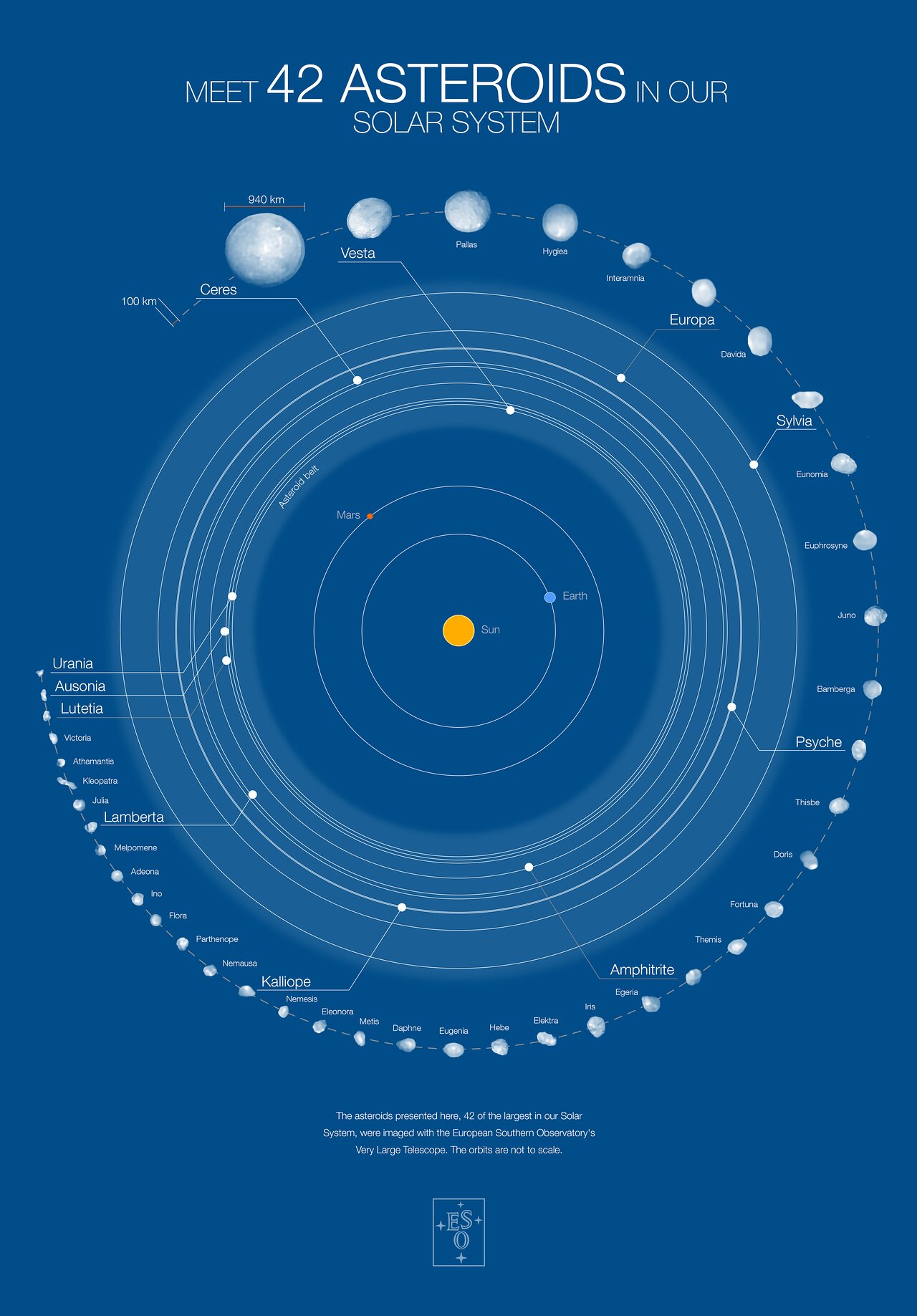Large Program of Asteroids using VLT/SPHERE instruments
The Director of the Astronomical Institute of the Romanian Academy (AIRA), Dr. Mirel Bîrlan is part of the international team that used the European Southern Observatory’s Very Large Telescope (ESO’s VLT) in Chile, and imaged the largest objects in the asteroid belt, located between Mars and Jupiter.
Never before had such a large group of 42 asteroids been imaged so sharply. The observations reveal a wide range of peculiar shapes, from spherical to dog-bone, and are helping astronomers trace the origins of the asteroids in our Solar System.
The detailed images of these 42 objects are a leap forward in exploring asteroids, made possible thanks to ground-based telescopes, and contribute to answering the ultimate question of life, the Universe, and everything [1].
“Only three large main belt asteroids, Ceres, Vesta and Lutetia, have been imaged with a high level of detail so far, as they were visited by the space missions Dawn and Rosetta of NASA and the European Space Agency, respectively,” explains Pierre Vernazza, from the Laboratoire d’Astrophysique de Marseille in France, who led the asteroid study published today in Astronomy & Astrophysics.
The previously small number of detailed observations of asteroids meant that, until now, key characteristics such as their 3D shape or density had remained largely unknown.
”Between 2017 and 2019, Pierre Vernazza successfully and efficiently led an international team of which I was part and which aimed to fill this gap by conducting a thorough survey of the major bodies in the asteroid belt”, said Dr. Mirel Bîrlan, the Director of the Astronomical Institute of The Romanian Academy (AIRA).
Most of the 42 objects in their sample are larger than 100 km in size; in particular, the team imaged nearly all of the belt asteroids larger than 200 kilometres, 20 out of 23. The two biggest objects the team probed were Ceres and Vesta, which are around 940 and 520 kilometres in diameter, whereas the two smallest asteroids are Urania and Ausonia, each only about 90 kilometres.
By reconstructing the objects’ shapes, the team realised that the observed asteroids are mainly divided into two families. Some are almost perfectly spherical, such as Hygiea and Ceres, while others have a more peculiar, “elongated” shape, their undisputed queen being the asteroid Kleopatra.
By combining the asteroids’ shapes with information on their masses, the team found that the densities change significantly across the sample. The four least dense asteroids studied, including Lamberta and Sylvia, have densities of about 1.3 grams per cubic centimetre, approximately the density of coal. The highest, Psyche and Kalliope, have densities of 3.9 and 4.4 grammes per cubic centimetre, respectively, which is higher than the density of diamond (3.5 grammes per cubic centimetre).
This large difference in density suggests the asteroids’ composition varies significantly, supporting the theory that the celestial objects were formed in different areas of the Solar System and migrated to their current location.
These findings were made possible thanks to the sensitivity of the Spectro-Polarimetric High-contrast Exoplanet REsearch (SPHERE) instrument mounted on ESO’s VLT.
Astronomers will be able to image even more asteroids in fine detail with ESO’s upcoming Extremely Large Telescope (ELT), currently under construction in Chile and set to start operations later this decade.
”The study of asteroids is a field where Romanian researchers contribute constantly and significantly. As an associate astronomer of the Astronomical Institute of the Romanian Academy and astronomer of the Paris Observatory, I encouraged and facilitated collaborations between researchers from Romania and France. We have two Romanian doctoral students and researchers with the title of doctor who study small bodies - comets, asteroids, meteoroids - in the Solar System, "said Mirel Bîrlan.
Among the recent results of Romanian researchers are observations of the potentially dangerous asteroid (99942) Apophis, made at the Astronomical Observatory in Cluj-Napoca, Feleacu station, observations of the asteroid Pallas, observations of the asteroid (6478) Gault.
"The Institute's strategy will continue to support research efforts in these directions. Our projects include studies of asteroids approaching dangerously close to Earth, the relationships between asteroids, comets and meteors, the interaction of interplanetary matter with Earth, studies of the dynamics of natural and artificial objects near Earth, "said AIRA Director Mirel Bîrlan.
Notes
[1] In The Hitchhiker's Guide to the Galaxy by Douglas Adams, the number 42 is the answer to the "Ultimate Question of Life, the Universe, and Everything." Today, 12 October 2021, is the 42nd anniversary of the publication of the book.
More information:
This research was presented in a paper to appear in Astronomy & Astrophysics
https://www.aanda.org/articles/aa/full_html/2021/10/aa41781-21/aa41781-21.html.
Original Press release colud be find at the address: http://rosa.ro/index.php/en/news-menu/stiri/5704-meet-some-of-the-42-biggest-asteroids-in-our-solar-system
Published on: Oct 13, 2021
